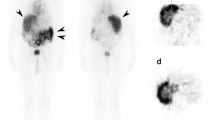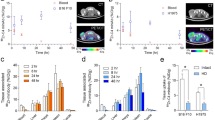Summary
The inaccessibility of radiolabeled antibody to poorly vascularized regions of solid tumors may reduce the therapeutic efficacy of these macromolecules. Theoretical mathematical models have predicted that increasing the protein dose administered would reduce the heterogeneity of radioantibody distribution. This investigation was undertaken to evaluate this hypothesis in experimental animal models. We have utilized the technique of macroautoradiography to demonstrate an increase in tumor penetration of the lower-affinity125I-labeled NP-4 or higher-affinity Immu-14 anti-carcinoembryonic antigen (anti-CEA) mAbs into small (60.25—0.4 g) and large (0.8–1.5 g) GW-39 and LS174T human colonic xenografts, grown subcutaneously in the nude mouse, when 400 µg unlabeled antibody is administered simultaneously with 10 µg (100 µCi) radioantibody. Further increases in protein to 800 µg result in a reduction in total tumor uptake of the antibody. These differences in mAb distribution could be visualized as early as 1 day after antibody injection. Improved mAb penetration was also achieved for the Mu-9 anti-CSAp (anti-mucin) antibody using 800 µg unlabeled antibody. An irrelevant antibody (AFP-7-31) was found to be homogeneously distributed 3 days after injection, even at a low protein dose. Attempts to improve mAb penetration by increasing the protein dose in the GS-2 colorectal tumor, a model that has low NP-4 accretion as a result physiological barriers separating antibody from antigen, were not successful. These results suggest that a more homogeneous distribution of radioantibody can be achieved by carefully selecting a dose of unlabeled antibody to coadminister. Work is currently in progress to determine the effect of improved tumor distribution of radioantibody on the therapeutic potential of a single dose of radioantibody.
Similar content being viewed by others
References
Badger CC, Krohn KA, Peterson AV, Shulman H, Bensh IP (1985) Experimental radiotherapy of murine lymphoma with131I-labeled Anti-Thy 1.1 monoclonal antibody. Cancer Res 45: 1536
Blumenthal RD, Sharkey RM, Kashi R, Goldenberg DM (1989) Comparison of the therapeutic efficacy and host toxicity of two different131I-labeled antibodies and their fragments in the GW-39 colonic cancer xenograft model. Int. J Cancer 44: 292
Blumenthal RD, Sharkey RM, Kashi R, Natale AM, Goldenberg DM (1989) Influence of animal host and tumor implantation site on radioantibody uptake in the GW-39 human colonic cancer xenograft. Int J Cancer 44: 1041
Blumenthal, RD, Sharkey RM, Goldenberg DM (1990) Current perspectives and challenges in the use of monoclonal antibodies as imaging and therapeutic agents. Adv Drug Deliv Rev 4: 279
Blumenthal RD, Sharkey RM, Kashi R, Natale AM, Goldenberg DM (1990) Physiological parameters responsible for difference in radioantibody uptake in experimental human tumor models (abstract). Proc Am Assoc Cancer Res 31: 61
Blumenthal RD, Sharkey RM, Kashi R, Goldenberg DM (1991) Suppression of tumor vascular function following radioimmunotherapy: Implications for multiple cycle treatments. Selec Cancer Ther (in press)
Bosslet K, Keweloh HCH, Hermentin P, Muhrer KH, Schultz G (1990) Percolation and binding of monoclonal antibody BW494 to pancreatic carcinoma tissues during high dose immunotherapy and consequences for future therapy modalities. Br J Cancer 62 (Suppl 10): 37
Buchegger F, Vacca A, Carrel S, Schreyer M, Mach JP (1988) Radioimmunotherapy of human colon carcinoma by131I-labeled monoclonal anti-CEA antibodies in a nude mouse model. Int J Cancer 41: 127
Carrasquillo JA, Krohn KA, Beumier P, McGriffin RW, Brown JP, Hellstrom KE, Hellstrom I, Larson SM (1984) Diagnosis and therapy for solid tumors with radiolabeled antibodies and immune fragments. Cancer Treat Rep 68: 317
Davies CL, Petterson EO, Lindmo T (1989) Change in antigen expression in human FME melanoma cells after exposure to hypoxia and acidic pH, alone or in combination. Int J Cancer 43: 350
Dykes PW, Bradwell AR, Chapman CE, Vaughan ATM (1987) Radioimmunotherapy of cancer: clinical studies and limiting factors. Cancer Treat Rev 14: 87
Esteban JM, Schlom J, Morrex F, Colcher D (1987) Radioimmunotherapy of athymic mice bearing human colon carcinomas with monoclonal antibody B72.3: histological and autoradiographic study of the effect on tumor and normal organs. Eur J Cancer Clin Oncol 23: 643
Ettinger DS, Order SE, Wharman MD, Parker MK, Klein JL, Leichner K (1982) Phase I–II study of isotopic immunoglobulin therapy for primary liver cancer. Cancer Treat Rep 66: 289
Fand I, Sharkey RM, McNally A, Brill AB, Som P, Yamamoto F, Primus FJ, Goldenberg DM (1986) Quantitative whole-body autoradiography of radiolabeled antibody distribution in a xenografted human cancer model. Cancer Res 46: 271
Fand I, Sharkey RM, Primus FJ, Cohen SA, Goldenberg DM (1987) Relationship of radioantibody localization and cell viability in a xenografted human cancer model as measured by whole-body autoradiography. Cancer Res 47: 2177
Fawwaz RA, Wang TST, Srivastava SC, Hardy MA (1986) The use of radionuclides for tumor therapy. Nucl Med Biol 13: 429
Fujimori K, Covell DG, Fletcher JE, Weinstein JN (1990) A modeling analysis of monoclonal antibody percolation through tumors: a binding-site barrier. J Nucl Med 31: 1191
Gold DV, Nocera MA, Stephens R, Goldenberg DM (1990) Murine monoclonal antibodies to colon specific antigen-p. Cancer Res 50: 6405
Goldenberg DM, Witte S, Elster K (1966) GW-39: a new human tumor serially transplantable in the golden hamster. Transplantation 4: 760
Goldenberg DM, Gaffar SA, Bennett SJ, Beach JL (1981) Experimental radioimmunotherapy of a xenografted human colonic tumor (GW-39) producing carcinoembryonic antigen. Cancer Res 41: 4354
Hansen HJ, Nemann ES, Ostello F, Moskie LA, Sharkey RM, Goldenberg DM (1989) Preclinical comparison of two specific anti-carcinoembryonic antigen (CEA) MAbs, NP-4 and Immu-14, in athymic nude mice bearing GW-39 human colon carcinoma xenografts (abstract). Proc Am Assoc Cancer Res 30: 414
Jain RK (1987) Transport of molecules across tumor vasculature. Cancer Metastasis Rev 6: 559
Jain RK (1987) Transport of molecules in the tumor interstitium: a review. Cancer Res 47: 3039
Jain RK (1988) Determinants of tumor blood flow: a review. Cancer Res 48: 2641
Jain RK, Baxter LT (1988) Mechanism of heterogeneous distribution of monoclonal antibodies and other macromolecules in tumors: significance of elevated interstitial pressure. Cancer Res 48: 7022
Kerr DJ, Kaye SB (1987) Aspects of cytotoxic drug penetration, with particular references to anthracyclines. Cancer Chemother Pharmacol 19: 1
Kerr DJ, Wheldon TE, Hydns S, Kaye SB (1988) Aspects of cytotoxic drug penetration with particular reference to anthracyclines. Xenobiotica 18: 641
Mach JP, Buchegger F, Forni M, Ritschard J, Berche C, Lumbroso JD, Schreyer M, Giardet C, Accolla RS, Carrel S (1981) Use of radiolabeled monoclonal anti-CEA antibodies for the detection of human carcinomas by external photoscanning and tomoscintigraphy. Immunol Today 2: 239
Mason DW, Williams AF (1987) In: Bonavida B, Collier RJ (eds) Membrane mediated cytotoxicity. Liss New York, p 279
McConahey PJ, Dixon FJ (1966) A method of trace iodination of proteins for immunologic studies. Int Arch Allergy 29: 185
Mattson J, Peterson P (1981) Influence of vasoactive drugs on tumor blood flow. Anticancer Res 1: 59
Matzku S, Tilgen W, Kalthoff H, Schmiegel WH, Brocker EB (1988) Dynamics of antibody transport and internalization. Int J Cancer 2 (Suppl) 11
Minchinton AI, Durand RE, Chaplin DJ (1990) Intermittant blood flow in the KHT sarcoma-flow cytometry studies using Hoechst 33 342. Br J Cancer 62: 195
Nederman T, Carlsson J, Malmovist M (1981) Penetration of substances into tumor tissue — a methodological study on cellular spheroids. In Vitro 17: 290
Nederman T, Carlsson J, Kuoppa K (1988) Penetration of substances into tumor tissue. Model studies using saccharides, thymidine and thymidine-5′-triphosphate in cellular spheroids. Cancer Chemother Pharmacol 22: 21
Ong GL, Mattes MJ (1989) Penetration and binding of antibodies in experimental human solid tumors grown in mice. Cancer Res 49: 4264
Pervez S, Epenetos AA, Mooi WJ, Evans DJ, Rowlinson G, Dhokia B, Krausz T (1988) Localization of monoclonal antibody AUA1 and its F(ab′)2 fragments in human tumor xenografts. An autoradiographic and immunohistochemical study. Int J Cancer (Suppl 3): 23
Pervez S, Paganelli G, Epenetos AA, Mooi WJ, Evans DJ, Krausz T (1988) Localization of biotinylated monoclonal antibody in nude mice bearing subcutaneous and intraperitoneal human tumor xenografts. Int J Cancer 43 (Suppl 3): 30
Pervez S, Kirkland SC, Epenetos AA, Mooi WJ, Evans DJ, Krausz T (1989) Effect of polarity and differentiation on antibody localization in multicellular tumor spheroid and xenograft models and its potential importance for in vivo immunotargeting. Int J Cancer 44: 940
Sharkey RM, Filion D, Fand I, Primus FJ, Goldenberg DM (1986) A human colon cancer metastasis model for radioimmunodetection. Cancer Res 46: 3677
Sharkey RM, Primus FJ, Goldenberg DM (1987) Antibody protein dose and radioimmunodetection of GW-39 human colon tumor xenografts. Int J Cancer 39: 611
Sharkey RM, Pykett MJ, Siegel JA, Alger EA, Primus FJ, Goldenberg DM (1987) Radioimmunotherapy of the GW-39 human colonic tumor xenograft with131I-labeled murine monoclonal antibody to carcinoembryonic antigen. Cancer Res 47: 5672
Sharkey RM, Primus FJ, Shochat D, Goldenberg DM (1988) Comparison of tumor targeting of mouse monoclonal and goat polyclonal antibodies to carcinoembryonic antigen in the GW-39 human tumorhamster host model. Cancer Res 48: 1823
Sutherland R, Buchegger F, Schreyer M, Vacca A, Mach JP (1987) Penetration and binding of radiolabeled anti-carcinoembryonic antigen monoclonal antibodies and their antigen binding fragments in human colon multicellular tumor spheroids. Cancer Res 47: 1627
Sylven B, Bois I (1960) Protein content and enzymatic assays of interstitial fluid from some normal tissues and transplanted mouse tumors. Cancer Res 20: 831
Thomas GD, Chappell MJ, Dykes PW, Ramsden DB, Godfrey KR, Ellis JRM, Bradwell AR (1989) Effect of dose, molecular size, and protein binding on tumor uptake of antibody or ligand: a biomathematical model. Cancer Res 49: 3290
Trotter MJ, Chaplin DJ, Olive PL (1989) Use of carbocyanate dye as a marker of functional vasculature in murine tumors. Br J Cancer 59: 706
Vaupel P, Fortmeyer HP, Runkel S, Kallinowski F (1987) Blood flow, oxygen consumption and tissue oxygenation of human breast cancer xenografts in nude rats. Cancer Res 47: 3496
Vessella RL, Alvarez V, Chiou RK, Rodwell J, Elson M, Palme D, Shafer R, Lange P (1987) Radioimmunoscintigraphy and radioimmunotherapy of renal cell carcinoma xenografts. NCI Monogr 3: 159
Wahl RL, Liebert M, Wilson BS (1986) The influence of monoclonal antibody dose on tumor uptake of radiolabeled antibody. Cancer Drug Deliv 3: 243
West GW, Weichselbaum R, Little JB (1980) Limited penetration of methotrexate into human osteosarcoma spheroids as a proposed model for solid tumor resistance to adjuvant chemotherapy. Cancer Res 40: 3665
Wiig H, Tveit E, Hultborn R (1982) Interstitial fluid pressure in DMBA-induced rat mammary tumors. Scand J Clin Lab Invest 42: 159
Zalcberg JR, Thompson CH, Lichtenstein M, McKenzie IFC (1984) Tumor immunotherapy in the mouse with the use of131I-labeled monoclonal antibodies. J Natl Cancer Inst 72: 697
Author information
Authors and Affiliations
Additional information
This work has been supported in part by USPHS grants CA-37895, CA 39841, and RR-05 903 (Division of Research Resources), National Institutes of Health, Department of Health and Human Services
Research fellow of the Dutch Cancer Society
Rights and permissions
About this article
Cite this article
Blumenthal, R.D., Fand, I., Sharkey, R.M. et al. The effect of antibody protein dose on the uniformity of tumor distribution of radioantibodies: An autoradiographic study. Cancer Immunol Immunother 33, 351–358 (1991). https://doi.org/10.1007/BF01741594
Received:
Accepted:
Issue Date:
DOI: https://doi.org/10.1007/BF01741594




